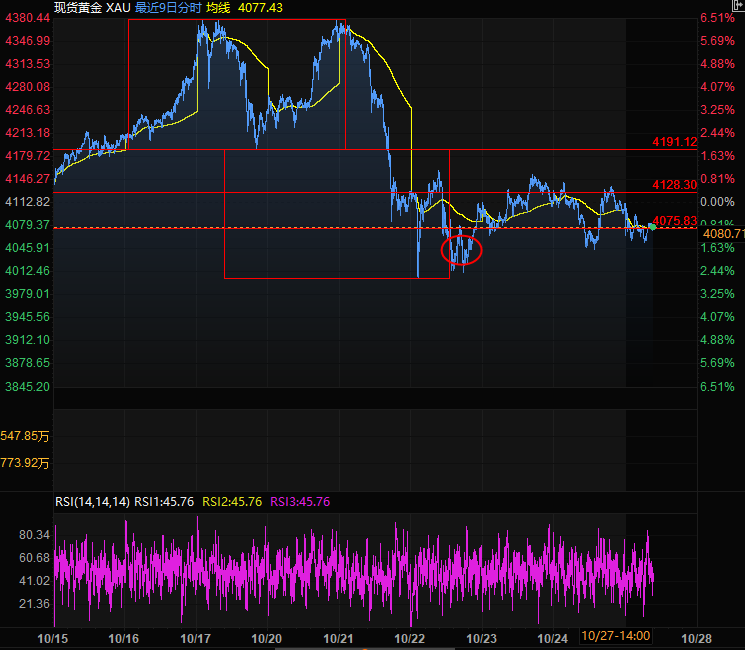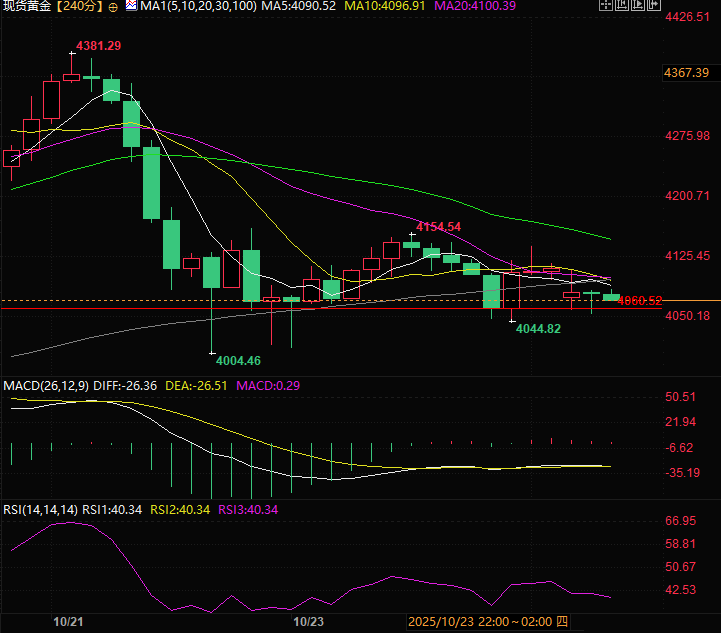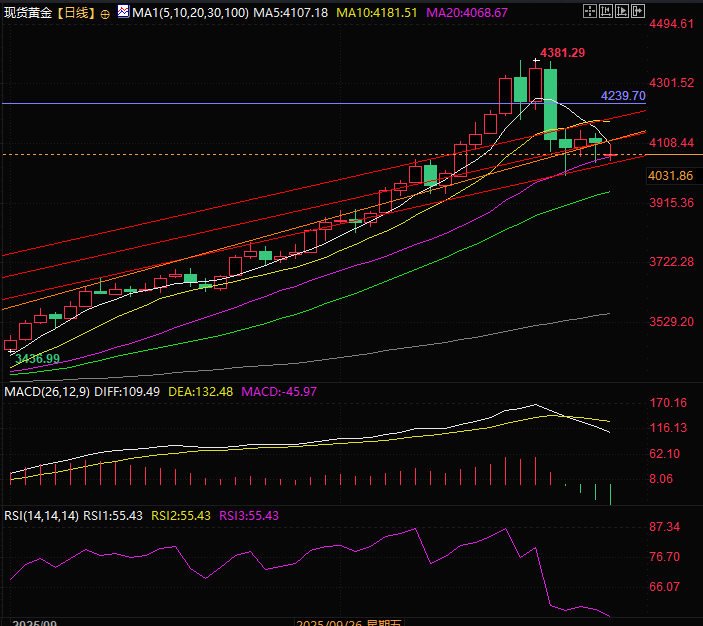A bull-bear showdown between retail investors and institutions? Can 4050 become a bull market defense line?
2025-10-27 15:41:46
The core trigger for this pullback was progress in US-China trade negotiations, with both sides signaling that a comprehensive agreement was nearing completion. This agreement is expected to ease some of the economic risks and geopolitical tensions that had previously provided key price support for gold.
Looking back at last week's performance, gold prices have already shown signs of a correction, with a cumulative weekly decline of 3.3%. Notably, on October 21st, gold prices experienced an extreme single-day plunge of over 6.3%, marking the largest single-day drop since 2013. This decline continued on October 24th, ultimately closing at $4,112.82 per ounce. In US dollar terms, the gold price fell by over $138 in a single week, making it one of the largest single-week declines in history.

Review of previous rally: Support logic and overbought concerns
Spot gold had previously experienced an explosive rise, with prices breaking through the historical high of $4,380 per ounce last Monday. Near the close of trading on October 20, the price of gold even hit a peak above $4,381 per ounce.
During this bull market, the cumulative increase in gold prices this year has remained at around 55%. The supporting logic behind this is clear: on the one hand, it is the fundamental support provided by the continued gold purchases by central banks of various countries; on the other hand, it is the so-called "currency depreciation transaction" - in order to avoid the risk of uncontrolled budget deficits, investors actively stay away from sovereign debt and fiat currency assets and turn to gold allocation.
However, after a short-term rapid rise, market concerns gradually emerged. As early as October 6, Nikki Hills, head of research at precious metals refiner MKS Pool, warned in a report to clients: "Across all technical indicators, gold is in a crowded trade and is already overstretched."
Two weeks later, on October 20, when gold prices soared to an all-time high of around $4,400 an ounce, Heraeus precious metals trader Marc Lefevre further warned that the commodity's "overbought levels are becoming further exacerbated."
In fact, this pullback was not without warning. After breaking its all-time high in 2025, gold surged a further 30% in just two months, continuing to accumulate overbought pressure. In the New York Mercantile Exchange (Comex) futures market, the ratio of interest in gold put options (Put) relative to call options (Call) has risen to one of the highest levels since the 2008 global financial crisis, reflecting the market's long-standing expectations for a pullback.
Similarly, there is a clear high point in sentiment in the technical aspect, as also mentioned in previous articles.
Central Bank Policy Window: Expectations of Fed rate cuts become a key variable
This week will be a period of intensive release of central bank policies. The central banks of the United States, Japan and the eurozone will all announce their latest policy decisions, which is expected to have further impact on the gold trend.
The market generally expects the Federal Reserve to implement a 25 basis point interest rate cut, while the European Central Bank and the Bank of Japan are likely to maintain their current interest rates. Last Friday's unexpected decline in US CPI, coupled with the lack of new CPI data for immediate reference due to the US government shutdown, further reinforced market bets on a Fed rate cut.
From a trading logic perspective, gold itself does not generate interest income, and downward borrowing costs usually reduce the opportunity cost of holding gold. Therefore, the Fed’s interest rate cut is expected to have a potential positive impact on gold prices.
Market reactions diverge: retail investors buying the dip and professional institutions taking action
Faced with the gold price correction, different market participants showed vastly different reactions. In Bangkok's Chinatown, Thailand's gold trading hub, 57-year-old Sunisa Kodkasong, a textile factory worker, offered a representative example: "Gold is the best investment. We decided to pool all our funds and enter the market today because we knew the price had fallen."
Retail investors who hold this view are not alone. From Singapore to the United States, traders have reported that after last week's plunge in gold prices, the number of retail investors interested in buying gold has surged, and some affordable gold bars have even sold out. Sunisa's attempt to buy at the bottom was thwarted by the sale of the gold bars of his preferred size.
At the same time, the movements of professional institutions have also attracted attention. Nearly 1,000 professional gold traders, brokers, and refiners gathered in Kyoto, Japan, to attend the largest annual precious metals industry conference (hosted by the London Bullion Market Association (LBMA)) which opened on October 26.
The conference, which boasts record attendance, is expected to focus on the intensifying war for talent among gold traders. Despite remaining cautious amidst the recent price rally, these professionals remain enthusiastic about the gold market.
Market outlook: Healthy correction or bull market turning point?
Regarding the nature of this pullback, the focus of market controversy is "whether gold has reached a bull market turning point or is it just a short-term healthy pullback."
Kyle Rodda, senior financial market analyst at Capital.com, expressed a representative view: "The market is currently returning to a more fundamentally driven operating logic and is becoming more rational overall. The progress in the China-US trade negotiations has exceeded market expectations, triggering a certain degree of immediate market reaction."
Nicky Hills, who previously warned of risks in advance, further analyzed: "A bull market always needs a healthy correction to squeeze out market bubbles and ensure the sustainability of the cycle. Gold prices should enter a consolidation phase and return to a more stable bullish trend track."
It is important to note that the plunge in gold prices on October 21 had an unusual feature: the decline was basically limited to the precious metals market, and other major markets such as stocks, U.S. Treasuries, and crude oil were hardly affected the next day.
There is no clear single cause for this decline. Some traders believe it was caused by hedge funds taking profits, while others say Chinese banks carried out sell-off operations. The market is still digesting the specific impact of this round of fluctuations.
Technical Analysis:
The spot gold time-sharing chart shows that the gold price is fluctuating in a range, and the rebound in the Asian session is weak. It is currently competing for the neckline of the double bottom pattern in the red circle around 4075. 4128 is the first pressure point of the rebound, and the support is at 4075. After that is the previous low of 4000 points, which is also an important integer level for gold.
If the gold price cannot hold 4075, it is likely to retest 4000 points. It is worth noting that the European and American time periods are generally the main time points for this wave of gold rise. If a rebound begins, gold may be the first to turn around in these two time periods.

(Spot gold daily chart)
The four-hour chart of spot gold shows that the moving averages are all in a bearish arrangement, with some support around 4060.

(Spot gold 4-hour chart)
The daily chart of spot gold shows that the short-term support near 4050-4060 is provided by the 20-day line and the lower track of the rising channel. The pressure level is at the suspected head and shoulders neckline of the orange line and the middle track of the rising channel, which is around 4130.

(Spot gold daily chart, source: Yihuitong)
At 15:35 Beijing time, spot gold was trading at $4070.49 per ounce.
- Risk Warning and Disclaimer
- The market involves risk, and trading may not be suitable for all investors. This article is for reference only and does not constitute personal investment advice, nor does it take into account certain users’ specific investment objectives, financial situation, or other needs. Any investment decisions made based on this information are at your own risk.





















